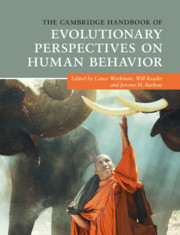Book contents
- The Cambridge Handbook of Evolutionary Perspectives on Human Behavior
- The Cambridge Handbook of Evolutionary Perspectives on Human Behavior
- Copyright page
- Dedication
- Contents
- Figures
- Tables
- Contributors
- Preface
- Acknowledgments
- Part I The Comparative Approach
- Part II Sociocultural Anthropology and Evolution
- Part III Evolution and Neuroscience
- Part IV Group Living
- Part V Evolution and Cognition
- Part VI Evolution and Development
- Part VII Sexual Selection and Human Sex Differences
- 26 Survival, Selection, and Sex Differences in Fear
- 27 The Enigmatic Urge
- 28 Are Humans Peacocks or Robins?
- 29 Human Mate Selection
- 30 Kin Selection and the Evolution of Male Androphilia
- 31 Evolutionary Psychology
- Part VIII Abnormal Behavior and Evolutionary Psychopathology
- Part IX Applying Evolutionary Principles
- Part X Evolution and the Media
- Index
- References
27 - The Enigmatic Urge
How Sexual Desire Works
from Part VII - Sexual Selection and Human Sex Differences
Published online by Cambridge University Press: 02 March 2020
- The Cambridge Handbook of Evolutionary Perspectives on Human Behavior
- The Cambridge Handbook of Evolutionary Perspectives on Human Behavior
- Copyright page
- Dedication
- Contents
- Figures
- Tables
- Contributors
- Preface
- Acknowledgments
- Part I The Comparative Approach
- Part II Sociocultural Anthropology and Evolution
- Part III Evolution and Neuroscience
- Part IV Group Living
- Part V Evolution and Cognition
- Part VI Evolution and Development
- Part VII Sexual Selection and Human Sex Differences
- 26 Survival, Selection, and Sex Differences in Fear
- 27 The Enigmatic Urge
- 28 Are Humans Peacocks or Robins?
- 29 Human Mate Selection
- 30 Kin Selection and the Evolution of Male Androphilia
- 31 Evolutionary Psychology
- Part VIII Abnormal Behavior and Evolutionary Psychopathology
- Part IX Applying Evolutionary Principles
- Part X Evolution and the Media
- Index
- References
Summary
This chapter explores how motivation theory (Chapter 15) set into an evolutionary framework can illuminate sexual desire. As implied by its title, some features of sexual desire appear to be enigmatic. However, a study of the combination of causal processes and evolutionary psychology can make them less so.
Examples of enigmatic and seemingly inexplicable features of sexual desire are to be found at numerous points along the wide spectrum of sexual responses that people exhibit. These range from something all-embracing and even addictive, including homicidal sex-linked violence, through to the absence of desire: asexuality. Some men spend hours absorbed in the biologically nonfunctional activity of watching child pornography, thereby risking their freedom, marriages, and careers. Others require a fetish object, such as rubber, to be present in order to feel sexual desire.
- Type
- Chapter
- Information
- Publisher: Cambridge University PressPrint publication year: 2020
References
- 2
- Cited by



